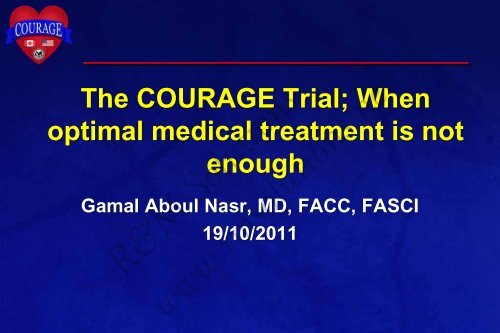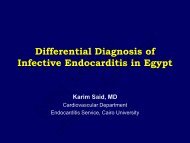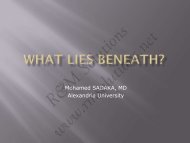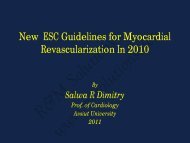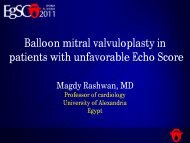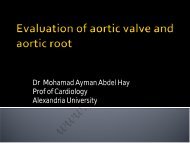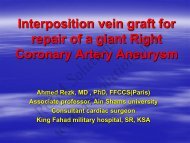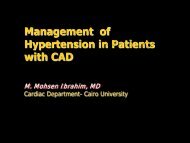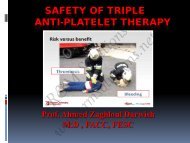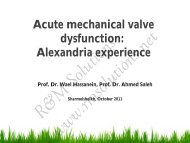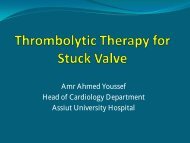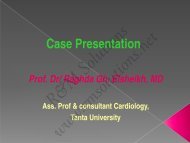OMT - cardioegypt2011
OMT - cardioegypt2011
OMT - cardioegypt2011
- No tags were found...
Create successful ePaper yourself
Turn your PDF publications into a flip-book with our unique Google optimized e-Paper software.
The COURAGE Trial; When<br />
optimal medical treatment is not<br />
enough<br />
Gamal Aboul Nasr, MD, FACC, FASCI<br />
19/10/2011<br />
R&M Solutions<br />
www.rmsolutions.net
COURAGE<br />
Clinical Outcomes Utilizing<br />
Revascularization and<br />
Aggressive Guideline-Driven<br />
Drug Evaluation<br />
R&M Solutions<br />
www.rmsolutions.net
COURAGGE is not PCI Vs.<br />
<strong>OMT</strong><br />
PCI added to Optimal Medical<br />
Therapy<br />
R&M Solutions<br />
will be Superior to<br />
Optimal Medical Therapy Alone<br />
www.rmsolutions.net
When optimal medical treatment is<br />
vA<br />
• Although <strong>OMT</strong> & life<br />
style modifications are<br />
being fully<br />
implemented, still<br />
some patients are<br />
symptomatic with<br />
evidence of residual<br />
ischemia<br />
not enough<br />
R&M Solutions<br />
vB<br />
• Because No enough<br />
resources.<br />
• Lack of initiatives from<br />
physician side<br />
• lack of compliance<br />
(pts.) to implement<br />
the full scale of <strong>OMT</strong><br />
+life style<br />
www.rmsolutions.net<br />
modification
A North American Trial<br />
19 US Non-VA Hospitals<br />
15 VA Hospitals<br />
R&M Solutions<br />
16 Canadian Hospitals<br />
50 Hospitals<br />
2,287 patients<br />
enrolled between<br />
6/99-1/04<br />
www.rmsolutions.net
Design<br />
• Randomization to PCI + Optimal Medical<br />
Therapy vs Optimal Medical Therapy alone<br />
• Intensive, guideline-driven medical therapy<br />
and lifestyle intervention in both groups<br />
R&M Solutions<br />
• 2.5 to 7 year (mean 4.6 year) follow-up<br />
www.rmsolutions.net
Primary Outcome<br />
Death or Nonfatal MI<br />
R&M Solutions<br />
www.rmsolutions.net
Secondary Outcomes<br />
• Death, MI, or Stroke<br />
• Hospitalization for Biomarker (-) ACS<br />
• Cost, Resource Utilization<br />
• Quality of Life, including Angina<br />
• Cost-Effectiveness<br />
R&M Solutions<br />
www.rmsolutions.net
Smoking<br />
Risk Factor Goals<br />
Variable<br />
Total Dietary Fat / Saturated Fat<br />
Dietary Cholesterol<br />
LDL cholesterol (primary goal)<br />
HDL cholesterol (secondary goal)<br />
Triglyceride (secondary goal)<br />
Physical Activity<br />
Cessation<br />
Goal<br />
Pharmacologic<br />
Optimal Medical Therapy<br />
• Anti-platelet: aspirin; clopidogrel in accordance with<br />
established practice standards<br />
• Statin: simvastatin ± ezetimibe or ER niacin<br />
• ACE Inhibitor or ARB: lisinopril or losartan<br />
• Beta-blocker: long-acting metoprolol<br />
• Calcium channel blocker: amlodipine<br />
R&M Solutions<br />
• Nitrate: isosorbide 5-mononitrate<br />
Applied to Both Arms by Protocol and Case-Managed<br />
www.rmsolutions.net
Lifestyle<br />
Optimal Medical Therapy<br />
• Smoking cessation<br />
• Exercise program<br />
• Nutrition counseling<br />
• Weight control<br />
R&M Solutions<br />
Applied to Both Arms by Protocol and Case-Managed<br />
www.rmsolutions.net
Long-Term Improvement in Treatment<br />
Targets (Group Median ± SE Data)<br />
Treatment Targets Baseline 60 Months<br />
PCI +<strong>OMT</strong> <strong>OMT</strong> PCI +<strong>OMT</strong> <strong>OMT</strong><br />
SBP 131 ± 0.77 130 ± 0.66 124 ± 0.81 122 ± 0.92<br />
DBP 74 ± 0.33 74 ± 0.33 70 ± 0.81 70 ± 0.65<br />
Total Cholesterol mg/dL 172 ± 1.37 177 ± 1.41 143 ± 1.74 140 ± 1.64<br />
LDL mg/dL 100 ± 1.17 102 ± 1.22 71 ± 1.33 72 ± 1.21<br />
HDL mg/dL 39 ± 0.39 39 ± 0.37 41 ± 0.67 41 ± 0.75<br />
R&M Solutions<br />
TG mg/dL 143 ± 2.96 149 ± 3.03 123 ± 4.13 131 ± 4.70<br />
BMI Kg/M² 28.7 ± 0.18 28.9 ± 0.17 29.2 ± 0.34 29.5 ± 0.31<br />
Moderate Activity (5x/week) 25% 25% 42% 36%<br />
www.rmsolutions.net
1.0<br />
0.9<br />
0.8<br />
0.7<br />
0.6<br />
0.5<br />
0.0<br />
Number at Risk<br />
Survival Free of Death from Any<br />
Cause and Myocardial Infarction<br />
Optimal Medical Therapy (<strong>OMT</strong>)<br />
PCI + <strong>OMT</strong><br />
R&M Solutions<br />
Hazard ratio: 1.05<br />
95% CI (0.87-1.27)<br />
P = 0.62<br />
0 1 2 3 4 5 6<br />
Years<br />
Medical Therapy 1138 1017 959 834 638 408 192 30<br />
PCI 1149 1013 952 833 637 417 200 35<br />
www.rmsolutions.net<br />
7
1.0<br />
0.9<br />
0.8<br />
0.7<br />
0.6<br />
0.5<br />
0.0<br />
Number at Risk<br />
Overall Survival<br />
PCI + <strong>OMT</strong><br />
<strong>OMT</strong><br />
R&M Solutions<br />
Hazard ratio: 0.87<br />
95% CI (0.65-1.16)<br />
P = 0.38<br />
0 1 2 3 4 5 6<br />
Years<br />
Medical Therapy 1138 1073 1029 917 717 468 302 38<br />
PCI 1149 1094 1051 929 733 488 312 44<br />
www.rmsolutions.net<br />
7
1.0<br />
0.9<br />
0.8<br />
0.7<br />
0.6<br />
0.5<br />
0.0<br />
Number at Risk<br />
Survival Free of Hospitalization<br />
<strong>OMT</strong><br />
PCI + <strong>OMT</strong><br />
for ACS<br />
Hazard ratio: 1.07<br />
95% CI (0.84-1.37)<br />
P = 0.56<br />
R&M Solutions<br />
0 1 2 3 4 5 6<br />
Years<br />
Medical Therapy 1138 1025 956 833 662 418 236 127<br />
PCI 1149 1027 957 835 667 431 246 134<br />
www.rmsolutions.net<br />
7
1.0<br />
0.9<br />
0.8<br />
0.7<br />
0.6<br />
0.5<br />
0.0<br />
Number at Risk<br />
Survival Free of<br />
Myocardial Infarction<br />
<strong>OMT</strong><br />
PCI + <strong>OMT</strong><br />
Hazard ratio: 1.13<br />
95% CI (0.89-1.43)<br />
P = 0.33<br />
R&M Solutions<br />
0 1 2 3 4 5 6<br />
Years<br />
Medical Therapy 1138 1019 962 834 638 409 192 120<br />
PCI 1149 1015 954 833 637 418 200 134<br />
www.rmsolutions.net<br />
7
Conclusions (Courage initial study)<br />
• As an initial management strategy in patients<br />
with stable coronary artery disease, PCI did not<br />
reduce the risk of death, MI, or other major<br />
cardiovascular events when added to optimal<br />
medical therapy<br />
R&M Solutions<br />
www.rmsolutions.net
Still remains an important question at<br />
that time!<br />
R&M Solutions<br />
www.rmsolutions.net
Even if PCI added to <strong>OMT</strong> did<br />
not affect mortality or<br />
subsequent occurrence of MI<br />
What about effect of<br />
angina & quality of life<br />
R&M Solutions<br />
www.rmsolutions.net
One of the main indications for<br />
PCI in stable CAD, is to improve<br />
symptoms & quality of life<br />
R&M Solutions<br />
www.rmsolutions.net
Freedom from Angina During<br />
Long-Term Follow-up<br />
Characteristic PCI + <strong>OMT</strong> <strong>OMT</strong><br />
CLINICAL<br />
Angina free – no.<br />
Baseline 12% 13%<br />
1 Yr ( P
R&M Solutions<br />
www.rmsolutions.net
R&M Solutions<br />
www.rmsolutions.net
Early improvement of angina frequency<br />
& quality of life up to 3 years<br />
R&M Solutions<br />
www.rmsolutions.net
R&M Solutions<br />
www.rmsolutions.net
In treating individual symptomatic patients<br />
with effort angina, Should we tell them<br />
“Kindly tolerate yr. symptoms & wait for 3 years<br />
then, PCI will have no additive benefits to your<br />
current R/ in relieving anginal pains”!!<br />
R&M Solutions<br />
www.rmsolutions.net
R&M Solutions<br />
www.rmsolutions.net
This may be from subjective side, Do we<br />
have objective evidence for significant<br />
changes in ischemic burden when PCI is<br />
added to <strong>OMT</strong><br />
R&M Solutions<br />
www.rmsolutions.net
R&M Solutions<br />
www.rmsolutions.net
R&M Solutions<br />
www.rmsolutions.net
The “Truth and Consequences” of Objective Ischemia: The<br />
COURAGE Trial Nuclear Substudy<br />
Dean J. Kereiakes, M.D.<br />
Medical Director, The Christ Hospital Heart and Vascular Center and<br />
the Lindner Research Center<br />
Chairman,Executive Committee, The Ohio Heart and Vascular Center,<br />
Cincinnati, Ohio<br />
Professor of Medicine, Ohio State University<br />
R&M Solutions<br />
www.rmsolutions.net
R&M Solutions<br />
www.rmsolutions.net
Ischemia Reduction ‡ 5%<br />
50<br />
40<br />
30<br />
20<br />
10<br />
0<br />
Primary Endpoint: % with Ischemia Reduction ‡<br />
5% Myocardium (n=314)<br />
33.3<br />
PCI + <strong>OMT</strong> (n=159)<br />
P=0.004<br />
R&M Solutions<br />
19.8<br />
<strong>OMT</strong> (n=155)<br />
www.rmsolutions.net
Ischemia Normalization* on Follow-Up MPS<br />
In Patients with Significant Ischemia Resolution<br />
% with Low Risk* MPS<br />
50<br />
40<br />
30<br />
31.4<br />
P=0.007<br />
20<br />
17.8<br />
10<br />
0<br />
PCI + <strong>OMT</strong> (n=53)<br />
<strong>OMT</strong> (n=29)<br />
*£1% ischemic myocardium<br />
R&M Solutions<br />
www.rmsolutions.net
Is this significant releive of<br />
ischemic burden by PCI + <strong>OMT</strong><br />
can lead to any beneficial effect<br />
on survival or new coronary<br />
events<br />
R&M Solutions<br />
www.rmsolutions.net
Rates of Death or MI by Ischemia Reduction<br />
Death or MI rate (%)<br />
50<br />
40<br />
30<br />
20<br />
10<br />
0<br />
RR=0.47 (95% CI=0.23-0.95)<br />
13.4<br />
P=0.037<br />
Ischemia Reduction ‡ 5%*<br />
n=82<br />
R&M Solutions<br />
*primary endpoint<br />
24.7<br />
No Ischemia Reduction<br />
n=232<br />
www.rmsolutions.net
Death or MI rate (%)<br />
Rates of Death or MI by Ischemia Reduction in<br />
Subset of 105 Patients with Moderate to Severe Pre-<br />
Rx Ischemia*<br />
50<br />
40<br />
30<br />
20<br />
10<br />
0<br />
16.2<br />
P=0.001<br />
Ischemia Reduction ‡ 5%<br />
n=68<br />
R&M Solutions<br />
32.4<br />
No Ischemia Reduction<br />
n=37<br />
www.rmsolutions.net<br />
*50% reduction
Death or MI rate (%)<br />
50<br />
40<br />
30<br />
20<br />
10<br />
0<br />
Rates of Death or MI by Residual Ischemia on 6-<br />
18m MPS<br />
0.0<br />
0%<br />
(n=23)<br />
P=0.063<br />
15.6<br />
1 - 4.9%<br />
(n=141)<br />
P=0.023<br />
R&M Solutions<br />
22.3<br />
5 -9.9%<br />
(n=88)<br />
P=0.002<br />
www.rmsolutions.net<br />
39.3<br />
‡ 10%<br />
(n=62)
Conclusions (Courage nuclear substudy)<br />
• PCI added to <strong>OMT</strong> was more effective in<br />
reducing ischemia and improving angina than<br />
<strong>OMT</strong> alone, particularly in patients with<br />
moderate to severe pre-RX ischemia<br />
R&M Solutions<br />
www.rmsolutions.net
COURAGE Conclusions!!<br />
Initial conclusion, 2007 Nuclear sub-study, 2008<br />
• As an initial management<br />
strategy in patients with<br />
stable coronary artery<br />
disease, PCI did not<br />
reduce the risk of death,<br />
MI, or other major<br />
cardiovascular events<br />
when added to optimal<br />
medical therapy<br />
R&M Solutions<br />
• PCI added to <strong>OMT</strong> was<br />
more effective in<br />
reducing ischemia and<br />
improving angina, with<br />
survival benefits & less<br />
CV events than <strong>OMT</strong><br />
alone, particularly in<br />
patients with moderate to<br />
severe pre-RX ischemia<br />
www.rmsolutions.net
Any confirmation from another<br />
RCT<br />
R&M Solutions<br />
www.rmsolutions.net
Cardiac Death Rate (%)<br />
Cardiac Death Rate Stratified by Spect Quantification of Ischemia and<br />
Treatment Modality †<br />
10<br />
8<br />
6<br />
4<br />
2<br />
0<br />
0.7<br />
6.3<br />
Medical RX<br />
1.0<br />
1.8<br />
2.9<br />
Revasc<br />
7110 16 1331 56 718 109 545 243 252 267<br />
3.7<br />
R&M Solutions<br />
4.8<br />
3.3<br />
0% 1-5% 5-10% 11-20% >20%<br />
*p < 0.0001 % Total Myocardium Ischemic<br />
†<br />
10,627 Consecutive patients followed 1.9 + 0.6 years.<br />
www.rmsolutions.net<br />
6.7<br />
2.0<br />
Hachamovitch et al. Circ 2003;107:2900<br />
*<br />
§
R&M Solutions<br />
www.rmsolutions.net
R&M Solutions<br />
www.rmsolutions.net
This when <strong>OMT</strong> including life style<br />
modification are fully implemented<br />
What about the reallife<br />
situation<br />
R&M Solutions<br />
www.rmsolutions.net
Because No enough resources or<br />
lack of compliance to implement<br />
the full scale of <strong>OMT</strong> as well as life<br />
style modification<br />
The real life situation<br />
R&M Solutions<br />
www.rmsolutions.net
Many Patients in Need of Lipid Lowering Therapy<br />
Remain Untreated – EUROASPIRE II<br />
39% untreated<br />
Lipid management assessed in 5556 patients with CHD at least 6 months<br />
after discharge who qualify for treatment<br />
EUROASPIRE II. Eur Heart J 2001;22:554–572<br />
R&M Solutions<br />
www.rmsolutions.net
EUROASPIRE II: 61% of patients are taking<br />
lipid-lowering drugs at interview<br />
BEL/GHE<br />
CZE/PP<br />
FIN/KUO<br />
FRA/LLRT<br />
GER/MUNS<br />
GRE/ATCI<br />
HUN/BUD<br />
IRE/DUB<br />
ITA/TV<br />
NET/ROT<br />
POL/CRA<br />
SLO/LJU<br />
SPA/BAR<br />
SWE/MAL<br />
UK/HL<br />
ALL<br />
European Society of Cardiology ESC<br />
42<br />
47<br />
49<br />
0 20 40 60 80 100<br />
51<br />
R&M Solutions<br />
57<br />
58<br />
60<br />
62<br />
61<br />
64<br />
65<br />
68<br />
68<br />
69<br />
76<br />
77<br />
www.rmsolutions.net<br />
EUROASPIRE II. Eur Heart J 2001; 22:554-72.
Many Patients that are Treated are Still not<br />
1464 (52%) not<br />
at goal on<br />
starting dose<br />
813<br />
(55%) not<br />
titrated<br />
448 (69%)<br />
not at goal<br />
Getting to Goal<br />
2829 patients †<br />
651 (45%)<br />
titrated<br />
R&M Solutions<br />
†Patients with and LDL-C goal of
% Patients receiving therapy<br />
60<br />
50<br />
40<br />
30<br />
20<br />
10<br />
0<br />
Cholesterol Goal Attainment in the Real World: The REALITY Study<br />
55<br />
LDL-C Goal Attainment*<br />
24<br />
26<br />
14<br />
(n=3173) (n=605) (n=634) (n=619)<br />
France<br />
Patients with CHD<br />
Germany<br />
Italy<br />
Spain<br />
R&M Solutions<br />
*LDL-C goal of
Situation for hypertension R/ is not<br />
even better!!<br />
R&M Solutions<br />
www.rmsolutions.net
Less than 50% of Hypertensive Patients in North<br />
America and Europe Receive Therapy<br />
Percentage (%)<br />
60<br />
55<br />
50<br />
45<br />
40<br />
35<br />
30<br />
25<br />
20<br />
15<br />
Percentage (%)<br />
100<br />
50<br />
40<br />
Country<br />
30 Country<br />
90<br />
80<br />
70<br />
60<br />
R&M Solutions<br />
20<br />
Wolf-Maier et al. JAMA 2003;289:2363–9<br />
Patients on therapy<br />
www.rmsolutions.net<br />
USA<br />
Canada<br />
Italy<br />
Sweden<br />
England<br />
Spain<br />
Finland<br />
Germany
Awareness, Treatment, and Control of Hypertension Have<br />
Not Increased Significantly in the USA<br />
US population (%)*<br />
80<br />
73<br />
70<br />
60<br />
51<br />
50<br />
55 54<br />
68 70<br />
40<br />
34<br />
31<br />
29<br />
30<br />
27<br />
20<br />
10<br />
10<br />
0<br />
NHANES II<br />
(1976-1980)<br />
*Adults with hypertension aged 18 to 74 years.<br />
†<br />
Controlled: BP
More than 70% of Treated Hypertensive Patients Are<br />
Not at BP Goal (
Poor Blood Pressure Control is<br />
Scotland<br />
Germany<br />
Finland<br />
Spain<br />
Russia<br />
Poland<br />
Italy<br />
Hungary<br />
France<br />
England<br />
Czech Republic<br />
Belgium<br />
Common in Europe<br />
R&M Solutions<br />
0 10 20 30 40<br />
Controlled at
Control rate breakdown by country<br />
Canada<br />
16.0<br />
USA<br />
27.4<br />
Scotland Finland<br />
17.5 20.5 Germany<br />
England<br />
22.5<br />
6.0<br />
France<br />
27.0<br />
Spain<br />
15.5<br />
Zaire<br />
2.5 Italy<br />
23.4<br />
R&M Solutions<br />
JNC-VI. Arch Intern Med. 1997;157:2413-2446. Burt VL. Hypertension. 1995;26:60-69. Mancia G.<br />
Eur Heart J. 1999;(suppl L):L14-L19.<br />
India<br />
9.0<br />
Australia<br />
7.0<br />
www.rmsolutions.net
MR FIT: CHD Deaths Associated with Lack of BP<br />
Deaths<br />
1500<br />
1000<br />
500<br />
0<br />
R&M Solutions<br />
www.rmsolutions.net
Is there really change in clinical<br />
practice after COURAGE<br />
• The the new survey—covering almost 500 000 patients<br />
from >1000 hospitals in the ACC National<br />
Cardiovascular Data Registry (NCDR)—shows that,<br />
at least among patients ultimately treated with PCI,<br />
there was little change in prescribing practice from preto<br />
post-COURAGE. The findings illustrate the difficulty<br />
of translating the results of randomized clinical trials<br />
into mainstream clinical practice, say Dr William B<br />
Borden (Cornell University, New York, NY) and colleagues in their paper<br />
in the May 11, 2011 issue of the Journal of the American Medical<br />
Association.<br />
R&M Solutions<br />
www.rmsolutions.net
• In their observational study, Borden and colleagues<br />
examined the use of <strong>OMT</strong> in 467 211 patients with<br />
stable CAD undergoing elective PCI and in the NCDR<br />
before (September 1, 2005 to March 25, 2007, before<br />
COURAGE publication) & after (July 1, 2007 to June<br />
30, 2009) the publication of the COURAGE trial.<br />
Analysis compared use of <strong>OMT</strong> both before PCI and at<br />
the time of discharge.<br />
R&M Solutions<br />
www.rmsolutions.net
• As being very much COURAGE-type patients:,"We<br />
found that less than half of people before PCI were<br />
taking <strong>OMT</strong>.<br />
• Specifically, before COURAGE, <strong>OMT</strong> was used in<br />
43.5% of patients prior to PCI, and this increased to<br />
only 44.7% in the period after COURAGE (p
• “When we looked over time, and particularly<br />
with publication of the COURAGE results, it<br />
did not seem like these practice patterns<br />
changed to any meaningful degree.”<br />
» Dr William B Borden,<br />
» main investigator of the COURAGE trial,<br />
» Clinical cardiology, May, 2011<br />
R&M Solutions<br />
www.rmsolutions.net
R&M Solutions<br />
www.rmsolutions.net
What are the real reasons for this<br />
much arguments<br />
R&M Solutions<br />
www.rmsolutions.net
“We, as a cardiology community,<br />
have to do a much better job of<br />
educating the non-cardiologists.”<br />
“Responsible interventionalists have always<br />
undertaken intervention against a background<br />
of having tried to control symptoms first with<br />
<strong>OMT</strong>.”<br />
R&M Solutions<br />
www.rmsolutions.net
To Conclude<br />
• Between this & that , the debate will continue<br />
• We as cardiologists (invasive and non-invasive)<br />
have been in long waiting for new clear<br />
guidelines<br />
• At the time of decision making (to act as<br />
responsible cardiologists!!), we should take our<br />
time to analyze pts’s medications, quantification<br />
of symptoms as well as the degree of ischemic<br />
burden to better reach conclusion about further<br />
benefits from mechanical revascularization<br />
R&M Solutions<br />
www.rmsolutions.net
Thank U 4 your attention<br />
R&M Solutions<br />
www.rmsolutions.net
Subgroup Analyses<br />
Baseline Characteristics Hazard Ratio (95% Cl) PCI Medical Therapy<br />
Myocardial Infarction<br />
Yes 1.15 (0.93-1.42) 0.19 0.18<br />
No 0.65 (0.40-1.06) 0.18 0.26<br />
Extent of CAD<br />
Multi-vessel disease 1.10 (0.83-1.46) 0.24 0.22<br />
Single-vessel disease 1.00 (0.77-1.32) 0.16 0.16<br />
Diabetes<br />
Yes 1.08 (0.87-1.34) 0.19 0.18<br />
No 0.87 (0.54-1.42) 0.19 0.24<br />
Angina<br />
CCS 0-I 1.27 (0.90-1.78) 0.17 0.14<br />
CCS II-III 0.71 (0.44-1.14) 0.15 0.21<br />
Ejection Fraction<br />
≤ 50% 1.06 (0.80-1.38) 0.22 0.22<br />
> 50% 1.06 (0.80-1.38) 0.22 0.22<br />
Previous CABG<br />
No 1.06 (0.80-1.38) 0.22 0.22<br />
Yes 1.06 (0.80-1.38) 0.22 0.22<br />
R&M Solutions<br />
www.rmsolutions.net<br />
0.25 0.50 1.00 1.50 1.75 2.00<br />
PCI Better<br />
Medical Therapy Better
Conclusions<br />
• As an initial management strategy in patients with<br />
stable coronary artery disease, PCI did not reduce<br />
the risk of death, MI, or other major cardiovascular<br />
events when added to optimal medical therapy<br />
• As expected, PCI resulted in better angina relief<br />
during most of the follow-up period, but medical<br />
therapy was also remarkably effective, with no<br />
between–group difference in angina-free status at<br />
5 years<br />
R&M Solutions<br />
www.rmsolutions.net
Implications<br />
• Our findings reinforce existing ACC/AHA clinical<br />
practice guidelines, which state that PCI can be safely<br />
deferred in patients with stable CAD, even in those<br />
with extensive, multivessel involvement and inducible<br />
ischemia, provided that intensive, multifaceted medical<br />
therapy is instituted and maintained<br />
• Optimal medical therapy and aggressive management<br />
of multiple treatment targets without initial PCI can be<br />
implemented safely in the majority of patients with<br />
stable CAD—two-thirds of whom may not require even<br />
a first revascularization during long-term follow-up<br />
R&M Solutions<br />
www.rmsolutions.net
Question<br />
&<br />
Answer<br />
R&M Solutions<br />
www.rmsolutions.net


